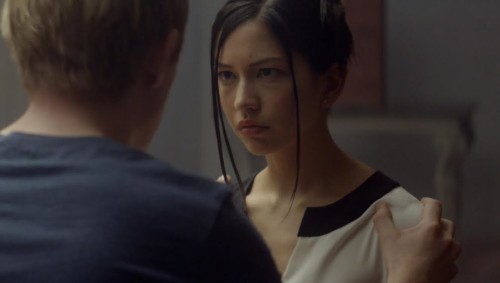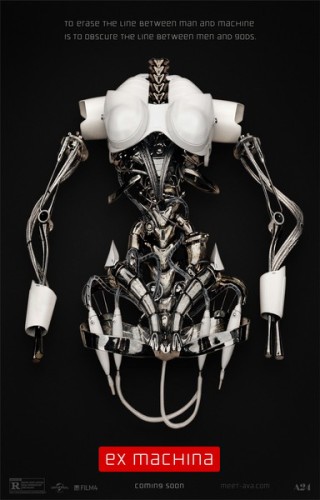This is a guest post by Zhuojie Chen.
In the opening minutes of Alex Garland’s Ex Machina, Nathan, the eccentric founder of the fictional company BlueBook, commissions Caleb, one of his programmer employees, to conduct the Turing test on Ava, an artificial intelligence subject. If Caleb cannot distinguish whether he is interacting with a computer or a human, then Ava passes the test. The bulk of the film focuses on the interplay between these three characters and attempts to bring up issues of gender and sexuality – specifically, performative (white) femininity. In this entry, however, I’d like to focus on Garland’s complete misfire with the character of Kyoko.
During Caleb’s first day in the research facility, he meets Ava (whose name is a variation of the Biblical Eve), the test subject with a (white) face crafted from his porn search history. She possesses internal circuitry that visibly lights up before him and speaks haltingly. In interviews, actress Alicia Vikander has noted that Garland instructed her to play Ava like a robot who wants to be a girl.
On Caleb’s second day, Kyoko (an Asian woman with a hairstyle that surely drew inspiration from Fu Manchu’s moustache) enters his room, silently places a tray on the table, and leaves. Later that evening, Kyoko spills wine as Nathan and Caleb eat dinner. Caleb attempts to placate Nathan’s angry outburst by telling Kyoko that he’ll take care of the spill, but Nathan’s reply – “Dude, you’re wasting your time talking to her; she doesn’t understand English” – left me with an acute awareness of the unfolding spectacle. In white America’s imagination, Asian American women take up dichotomous spaces: Dragon Ladies or China Dolls. As a recovering academic, I’m tempted to cite scholarly article after scholarly article to validate my point of view; but as a life-long Asian American consumer of pop culture, I see a system that consistently replicates itself.

Kyoko is a white man’s plot device; a foil to Ava; a trope that evokes the imagery of comfort women without delving into any of the trauma. She falls well within normative standards of beauty (thin, light-skinned), but Garland constructs her so that she is still a foreigner. Her silence functions in two ways: first, she doesn’t take up the space that Ava is allowed through her inquisitiveness; but her voicelessness also marks her as dangerous, as disloyal. And what of Nathan’s banal dismissal of her? “Hey, Kyoko. Go, go.” Like a post-racial hipster reimagining of “ching chong ding dong,” it too tries to juxtapose supposed Otherness with homegrown simplicity and fails at either cleverness or subversion.
We ought to contextualize Kyoko’s character within the larger framework of the way in which Garland navigates racial issues. Caleb eventually learns that Nathan has been building test subjects for quite some time. There’s Lily; by version 2.4.0, she’s a fully formed naked white woman who we see walking down a hallway. There’s Jasmine, a naked black woman who, by version 4.3.0, still doesn’t have a face. She never moves on her own; she never acquires agency. (In version 4.2.2, we’re treated to a shot of wigs.) And there’s Jade, a naked Asian woman racialized on her name alone. Jade, from versions 5.0.1 to version 5.2.3, asks Nathan, in accented English, “Why won’t you let me out?” Version 5.3 assaults her captor; version 5.4 tries to break free, slamming on glass walls, only to break off her own arms in the process.
After Caleb uncovers this footage, Kyoko reveals that she, too, is A.I. by peeling back layers of “skin.” I entertained the thought that Garland was, in this image, attempting to convey that Kyoko’s problematic depiction of Asian American womanhood had been filtered through Nathan’s eyes, as he had envisioned her. Unfortunately, Garland envisioned this film. The power of cinema is not simply representational; the power of cinema lies in its constant act of creation, of reification.

At the film’s conclusion, Ava and Kyoko join forces to kill Nathan. Ava loses half of an arm in the process; Kyoko loses her life (like a horror film, the lady robot of color doesn’t make it to the end). After the struggle, Ava steals into Nathan’s room and finds the defunct A.I. models. She unhooks her damaged arm and replaces it with Jade’s. Slowly, she peels off Jade’s skin and assembles those pieces on her own body, takes a white dress from another A.I., and leaves the facility with Caleb still locked inside. One of the last images we see is Caleb pounding on the door, a dead Kyoko mere feet away.

In one of Caleb’s first sessions with Ava, he says to her, “Mary’s a scientist, and her specialist subject is color….But she lives in a black and white room. She was born there and raised there and she can only observe the outside world on a black and white monitor. Then one day someone opens the door, and Mary walks out. And she sees a blue sky. And at that moment…she learns what it feels like to see color. The thought experiment was to show students the difference between a computer and a human mind. The computer is Mary in the black and white room; the human is when she walks out.”
How unfortunate, then, that in order to see color, in order to be truly human, Ava must actively participate in the erasure of women of color. From Luise Rainer in The Good Earth (1937), who won her first of two Oscars by playing a Chinese servant, to Emma Stone in Aloha (2015), who thought she could convincingly portray the quarter-Hawaiian, quarter-Chinese character Allison Ng, white women in Hollywood have long benefitted from systemic racism that centers white artists at every turn. The consequence of privilege is that it allows those who have it to be oblivious to its ill effects; privilege, by nature, craves inaction or continued ignorant actions; it necessitates an investment in the status quo.

They’re both Asian; didn’t you know?
I decided to be a filmmaker because I believe that women of color should proclaim ownership over the creation and dissemination of our images and stories. When Ava DuVernay asked her Twitter followers to name films that featured black, brown, Native, or Asian women leads, only a handful of films on that list featured an Asian American actress with an Asian American woman director at the helm. (And the drop-off between first and second efforts is alarming; Alice Wu, the writer/director of 2004’s Saving Face, has never made another feature.)
In 2014, I went to the Sundance Screenwriters Intensive with a feature script called M. Virgin, which is a comedy that deals with Asian American fetishism. This summer, I will take three scenes from the feature and turn them into a proof-of-concept short film. I hope you’ll support the project with a contribution, a follow, or both. Only systemic change is worth our collective investment.
Zhuojie Chen is a writer and filmmaker from Charlotte, North Carolina. She is a graduate of Georgetown University’s School of Foreign Service and New York University’s Gallatin School of Individualized Study. She lives and works in New York City, spent her childhood obsessed with Power Rangers, and will ardently defend Michelle Kwan’s performance at the 1998 Nagano Olympics. Once upon a time she went by Suzy; then she decided she liked her given name more.











